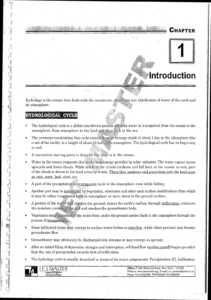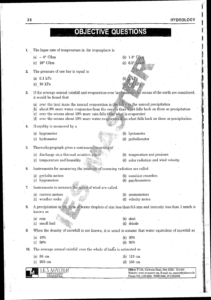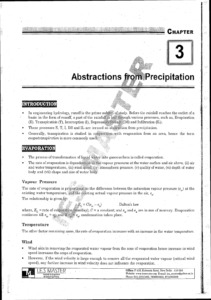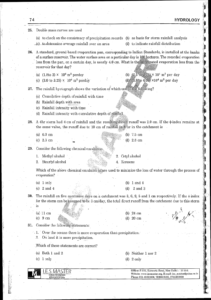
Table of Contents
IES MASTER GATE MATERIAL
HYDROLOGY
GATE – PSU – IES – GOVT EXAMS – STUDY MATERIAL
FREE DOWNLOAD PDF


ABOUT THE BOOK :
IES MASTER’S GATE MATERIAL IS USEFUL FOR NOT ONLY GATE ASPIRANTS BUT ALSO IES, PSU JOBS, GOVERNMENT JOBS AND MANY COMPETITIVE EXAMS. IES MASTERS IS ONE OF THE TOP MOST GATE COACHING INSTITUTES IN INDIA. A MUST HAVE BOOK FOR MAINLY GATE PREPARING CIVILIANS.
CONTENTS
-
-
Introduction
-
Precipitation and it’s measurement
-
Abstractions from precipitation
-
Surface Water Hydrology(Run off)
-
Stream Flow Measurement
-
Surface water Hydrology (Hydrographs)
-
Floods
-
Flood Routing
-
Ground Water
-
Hydrometeorology
-
HYDROLOGICAL CYCLE : The hydrological cycle is a global sun-driven process whereby water is transported from the oceans to the atmosphere, from atmosphere to the land then, back to the sea The processes constituting this cycle extend average depth of about 1 km in the lithosphere (the crust of the earth), to a height of about 5 km higher atmosphere. The hydrological cycle has no beginning or end. A convenient starting point to describe the cycle is in the oceans Water in the oceans evaporate due to the heat energy provided by solar radiation. The water vapour move upwards and forms clouds. much of the clouds condense and fall back to the oceans as rain, pa of the clouds is driven to the land areas by winds There they condense and precipitate onto the land ma as rain snow hail, sleet etc. A part of the precipitation may evaporate back to the atmosphere even while falling Another part may be intercepted by vegetation, structures and other such surface modifications from why it may be either evaporated back to atmosphere or move down to the ground surface.

A portion of the water that reaches the ground, enters the earth’s surface through infiltration, enhance the moisture content the soil and reaches the groundwater body Vegetation seen portion of the water from under the ground surface back to the atmosphere through process of transpiration Some infiltrated water may emerge to surface-water bodies as interflow, while other portions may become groundwater flow Groundwater may ultimately be discharged into streams or may emerge as springs. After an initial filling of depression storages and interception, overland flow (surface runoff begins per that the rate of precipitation exceeds that of infiltration. The hydrology cycle is usually described in terms of six major components.Evaporation is the transfer of water from a liquid state to a gaseous state, i.e., it quid to the vapour phase. precipitation is the deposition of water on the earth’s surface in the form of rain, snow, hail, from on. interception is the short term retention of rainfall by the foliage of vegetation. filtration is the movement of Water into the soil of the earth’s surface. percolation is the movement of water from one soil zone to a lower soil zone. transpiration is the soil moisture taken up through the roots of a plan and discharged into the atom through the foliage by evaporation. storage is the volume of water which gets stored in natural depressions of a basin runoff is the volume of water drained by a river at the outlet of a catchment

CATCHMENT AREA AND WATERSHED DIVIDE The area of land draining into a stream or a water course at a given location is called a catchment area other terms that are be a catchment area are drainage catchment, ninth age area, water basin and was in closed catchment the water converges to a single point inside know no, which may be a permanent lake lake, or a point where surface water is lost underground. The felling it to a single point. area covered by the catch Each catchment area is separated topographically from adjacent catchment area by a geographical be such as a ridge, hill or mountain.
The line which divides the surface runoff between two adjacent basins is called the topographic water divide, or the watershed divide, or simply the divide The divide follows the ridge line around the catchment, crossing the stream only at the outlet point marks the highest points between the basins, but isolated peaks within a basin may reach higher elevate than any point on the divide.
The line which divides the surface runoff between two adjacent basins is called the topographic water divide, or the watershed divide, or simply the divide The divide follows the ridge line around the catchment, crossing the stream only at the outlet point marks the highest points between the basins, but isolated peaks within a basin may reach higher elevate than any point on the divide.

PRECIPITATION Precipitation is the fall of water in various forms on the clouds. The usual forms are rain, glaze, hail, dew etc. ore studying the phenomenon of precipitation let us corner water vapours. Air in atmosphere can moisture in the form water vapours. The amount of the vapours absorbed by air depends upon rapture of air, the more is the temperature the more water vapours it can absorb. water vapour exerts a partial pressure on the water surface called vapour pressure. The amount of was r present in air is indirectly expressed in term of vapour pressure. he evaporation continues, a state of equilibrating is reached when the air is fully saturated with vamp therefore it cannot absorb more vapours. The vapours then exert pressure which is known as saturate r pressure (ea) is increases with increase in temperature us consider an of parcel of air at a temperature T and a vapour pressure(ea.) indicated by pt. A. action vapour pressure at that temperature is indicated by pt. B. The intercept deficit vapours are added to the parcel of air, the pt. A will move to pt. B when air is full.

TYPES OF PRECIPITATION Depending upon the factors responsible for if ingand Hangere are following types of precipitation: Convective precipitation: It occurs due to be The air close to the earth surface gets heated, and td decreases. Consequently, the air rises upwards in the ionosphere and it gets cooled adiabatically to form a cloud Precipitation Orographic Precipitation: Orographic rainfall tour due to ascent of air forced by mountain barriers, the mountain barriers lying across the direction of air flow force laden air to rise along the mountain slope. It results in and precipitation. (iii) Cyclonic Precipitation: A cyclone a large zone of low pressure which is surrounded by circular wind motion. Air tend low pressure zone from. and displaces low pressure cyclonic precipitation to move into the surrounding area air upwards. Thus occurs due to displacement of air in upwards direction due to pressure difference. (iv Frontal Precipitation: It is a type of cyclonic precipitation When two contrasting air masses (cold polar air mass and warm westerly air mass common opposite directions converge along ram wind is lifted upward along Inez, a front 18 formed. this front where as Cold air being heavier settles downward. Because the two types of front (warm and cold) have different temperature and density, frontal precipitation occurs when they clash with each other.

Leave a Reply